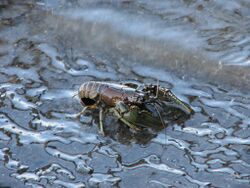Biology:Orconectes virilis
| Orconectes virilis | |
|---|---|

| |
| Adult | |
| Scientific classification | |
| Domain: | Eukaryota |
| Kingdom: | Animalia |
| Phylum: | Arthropoda |
| Class: | Malacostraca |
| Order: | Decapoda |
| Suborder: | Pleocyemata |
| Family: | Cambaridae |
| Genus: | Faxonius |
| Species: | F. virilis
|
| Binomial name | |
| Faxonius virilis (Hagen, 1870) [1]
| |
Faxonius virilis is a species of crayfish known as the virile crayfish, northern crayfish, eastern crayfish, and lesser known as the lake crayfish or common crawfish. Faxonius virilis was reclassified in August 2017, and the genus was changed from Orconectes to Faxonius.[2] It is native to eastern United States and southeast Canada.
Ecology
Faxonius virilis can be found under stones and logs in lakes, streams, and wetlands, where they hide from predators, such as fish. They are identified by the brown of rust-red carapace and large chelipeds, which are usually blue in colour. Faxonius virilis feeds on a wide range of plants and invertebrates, as well as tadpoles and even small fish.
Distribution
Faxonius virilis is found in southern Canada from Alberta to Quebec and in the northern United States , but has become an invasive species in parts of North America outside its native range, and was discovered in the United Kingdom in 2008.[3] It is listed as a species of Least Concern on the IUCN Red List.[4]
Uses
Faxonius virilis is used as fishing bait and as food for humans, and also as aquarium food for carnivorous fish.[5]
References
- ↑ "Faxonius virilis". Integrated Taxonomic Information System. https://www.itis.gov/servlet/SingleRpt/SingleRpt?search_topic=TSN&search_value=97425. Retrieved October 20, 2010.
- ↑ Keith A Crandall; Sammy De Grave (2017). "An updated classification of the freshwater crayfishes (Decapoda: Astacidea) of the world, with a complete species list". Journal of Crustacean Biology 37 (5): 615–653. doi:10.1093/jcbiol/rux070.
- ↑ Daniel Ahern; Judy England; Adam Ellis (2008). "The virile crayfish, Orconectes virilis (Hagen, 1870) (Crustacea: Decapoda: Cambaridae), identified in the UK". Aquatic Invasions 3 (1): 102–104. doi:10.3391/ai.2008.3.1.18. Archived from the original on 2009-02-19. https://web.archive.org/web/20090219133703/http://aquaticinvasions.ru/2008/AI_2008_3_1_Ahern_etal.pdf.
- ↑ S. Adams; G. A. Schuster; C. A. Taylor (2010). "Orconectes virilis". IUCN Red List of Threatened Species 2010: e.T153831A4551026. doi:10.2305/IUCN.UK.2010-3.RLTS.T153831A4551026.en. https://www.iucnredlist.org/species/153831/4551026.
- ↑ Krista Kagume (2008). Ontario Nature Guide. Edmonton: Lone Pine Publishing. ISBN 978-1-55105-564-0.
External links
- "UK Crayfish Website". Buglife – The Invertebrate Conservation Trust. http://www.crayfish.org.uk/.
- "USGS Nonindigenous Aquatic Species – Virile Crayfish". US Geological Survey. https://nas.er.usgs.gov/queries/FactSheet.aspx?SpeciesID=215.
Wikidata ☰ Q3933612 entry



